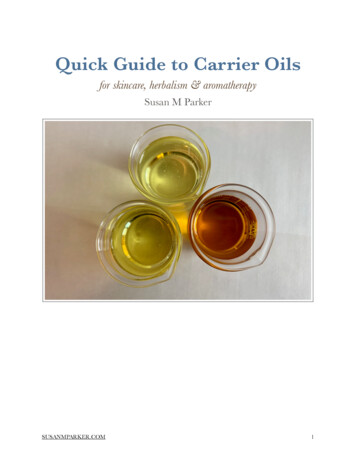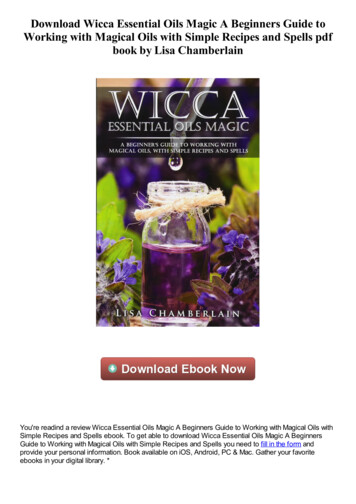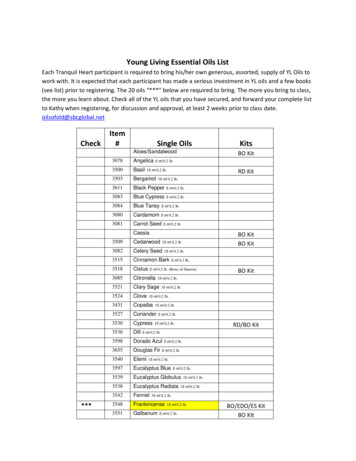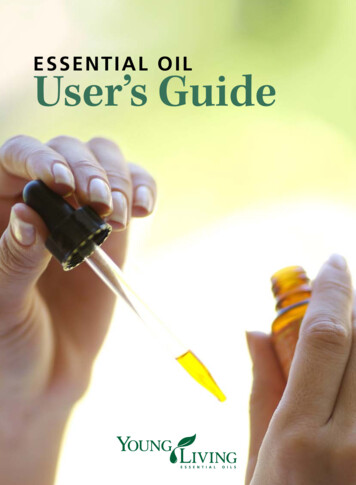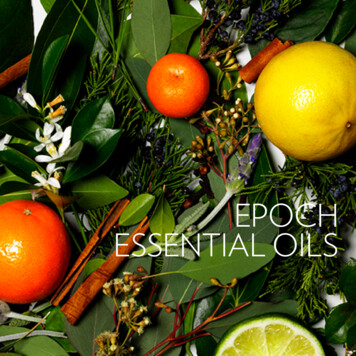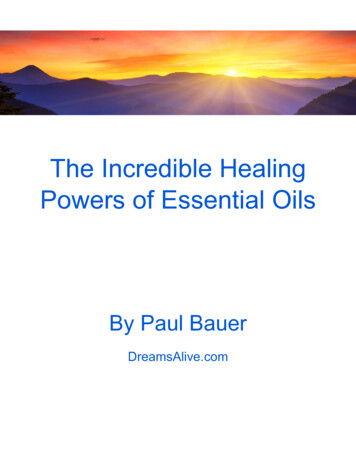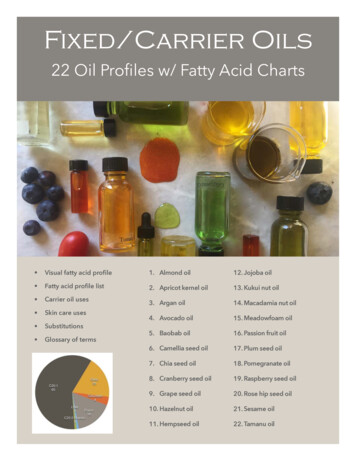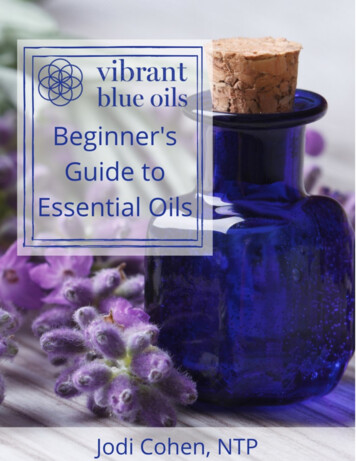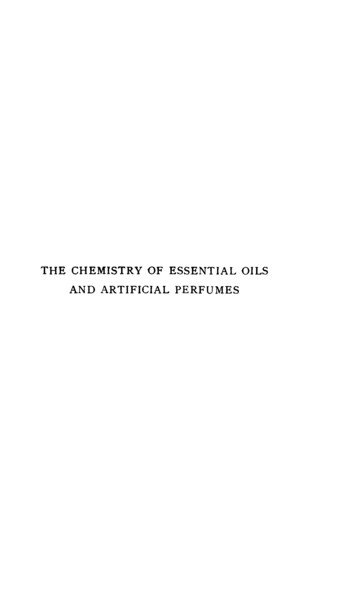
Transcription
THE CHEMISTRY OF ESSENTIALA N D ARTIFICIALPERFUMESOILS
UNIFORM WITH THIS VOLUMET H E CHEMISTRY OF ESSENTIAL OILSANDARTIFICIAL PERFUMESBYERNEST J. PARRY, B.Sc. (LOND.), F.I.C., F.C.S.Fourth Edition, Revised and EnlargedVOLUME I.i MONOGRAPHS ON E S S E N T I A LIOILSRoyal Svo. 52 Illustrations. 552 viii pagesPrice 305. net (post free 315. home; 315. d. abroad]CASH WITH ORDERPublished by . .SCOTT, G R E E N W O O D A N D SON8 BROADWAY, LUDGATE, LONDON, E.C. 4
VOLUMET H EESSII.C H E M I S T R YENTIAO FLOILSANDA R T I F I C I A LP E R F U M E SBYE R N E S T J. P A R R Y , B.Sc. (LOND.), F.I.C., F.C.S.OF GRAY'S INN, BARRISTER-AT-LAWAUTHOR OF "FOOD AND DRUGS," "THE CHEMISTRY OF PIGMENTS," ETC.FOURTH EDITION, REVISED AND ENLARGEDV O L U M E II.(i) T H EESSENTIAL(2) C O N S T I T U E N T DONSCOTT,G R E E N W O O DA N D8 BROADWAY, LUDGATE, E.G. 41922[All rights reserved]N E W YORKD. V A N N O S T R A N D COMPANYE I G H T WARREN STREETS O N
BIBLIOGRAPHICAL NOTXFirst Edition (Demy 8vo)1899Second Edition, Revised and Enlarged (Demy 8vo)1908Third Edition, Revised and Enlarged'to Two Volumes (Royal8vo), of which this is Volume IT.1 June, 1919Fourth Edition (Vol. II), Revised and Enlarged. . . Feh nary, 1922
P R E F A C E TO T H E F O U R T HEDITION.IN bringing the second volume of this work up to date, I haveto express my thanks to Mr. T. H. Durrans, M.Sc., F.I.C., ofMessrs. Boake, Eoberts & Co.'s Research Laboratories for contributing the chapter on the Relationship of Odour to ChemicalConstitution, a subject to which Mr. Durrans has devoted considerable attention.I have also to thank Mr. Maurice Salamon,B.Sc., and Mr. C. T. Bennett, B.Sc., F.I.C., for reading andrevising the chapter on the Analysis of Essential Oils.E R N E S T J. PARRY.56X GREAT DOVER STREET,LONDON, S.E. 1, January, 1922.
CONTENTS O F V O L U M E II.CHAPTER I.THE ESSENTIAL OIL IN THE PLANCultivation and Structure of the Plant—Experiments on Plants—Secretion ofEssential Oil—Glucose—The Linalol, Geraniol, Thujol and Mentholgroups and their Composition—EsterificationPAGES1-24CHAPTER II.THE RELATIONSHIP BETWEEN ODOUR AND CHEMICAL COMPOSITION.Strength of Odour—Theory of es—Phenols and Phenolic Compounds—Aldehydes—Chemical Reactions that produce Odours25-37CHAPTER III.THE CONSTITUENTS OF ESSENTIAL OILS.Hydrocarbons; Heptane—1?erpenes—Pinene and its Compounds—Campene—Fenchene — Thujene — . Sesquiterpenes: Bisabolene—Cadinene. Alcohols: Methyl AlcoholEthyl Alcohol—Higher Aliphatic Alcohols—-Geraniol—Closed ChainAlcohols. Terpene Alcohols Terpineol—Pinenol. Esters Benzyl Esters.Aldehydes Aliphatic Ketones 4 cetone—lonone — Santenone — Carvone—Camphor. Phenolsand Phenolic Compounds: Cresol Compounds—Thymol. Oxides andLactones :Coumarin—Eucalyptol. Nitrogen Compounds Nitrobenzene—Artificial Musk. Sulphur Compounds Butyl Isothiocyanate—VinylSulphide. Acids Formic Acid—Acetic Acid—Butyric Acid—BenzoicAcid .38-298CHAPTER IV.THE ANALYSIS OF ESSENTIAL OILS.Specific Gravity. Optical Methods Refraction—Polarimetry. Melting andSolidifying Points—Boiling Point and Distillation—Determination ofEsters—Tables for the Calculation of Esters and Alcohols—Determinationof Alcohols—Tables—Separate Determination of Citronellol in Presenceof Geraniol—Determination of Aldehydes and Ketones—MiscellaneousProcesses—Determination of Phenols—Detection of Chlorine—Determination of Hydrocarbons—Hydrogen—Number of Essential Oils—Detection of some Common Adulterants.299-357IKDHX359 365
CHAPTEE I.THE ESSENTIAL OIL IN THE PLANT.AN absolutely scientific definition of the term essential cr volatile oils ishardly possible, but for all practical purposes they may be defined asodoriferous bodies of an oily nature obtained almost exclusively fromvegetable sources, generally liquid (sometimes semi-solid or solid) atordinary temperatures, and volatile without decomposition. This definition must be accepted within the ordinary limitations which are laiddown by the common acceptation of the words, which will make themselves apparent in the sequel, and show that no more restricted definitionis either advantageous or possible. Many essential oils, for example,are partially decomposed when distilled by themselves, and some evenwhen steam distilled.The volatile oils occur in the most varied parts of the plant anatomy,in some cases being found throughout the various organs, in othersbeing restricted to one special portion of the plant. Thus in the conifers,of which the pine is a type, much volatile oil is found in most parts ofthe tree; whereas in the rose, the oil is confined to the flower ; in thecinnamon, to the hark and the leaves, with a little in the root; in theorange family, chiefly to the flowers and the peel of the fruit; and in thenutmeg, to the fruit. The functions of these bodies in the plant economyare by no means well understood. Whilst it is easy to understand thata fragrant odour in the unfertilised flower may be of great value inattracting the insects with the fecundating pollen, this can have nobearing on the occurrence of odorous bodies in, say, the bark or internaltissues, except in so far as the presence of essential oil in one part of theplant is incidental to, and necessary for, its development, and .transferenceto the spot at which it can exercise its real functions. There may alsobe a certain protective value in the essential oils, especially against theattacks of insects. At present one is compelled to class the majority ofthe essential oils as, in general, belonging to the by-products of themetabolic processes of cell life, such as are many of the alkaloids,,colouring matters, and tannins; with, possibly, in certain cases, excretionary functions. Some are undoubtedly the results of, pathologicalprocesses. The structures of the plant which carry the secreted oilsoccur in the fibro-vascular as well as in the fundamental tissues. Dependent on their mode of origin, the receptacles may be either closedcells containing nothing other than the matter secreted, or they may bevascular structures which have their origin in the gradual absorption ofadjacent cell walls, and the consequent fusion of numerous cells intoone vessel; or, again, they may be intercellular spaces, large cavitiesformed in two distinct ways, (1) by the decomposition of a number ofadjacent cells, leaving a cavity in their place, whose origin is thus lysigenous, (2) by the separation of adjacent cell walls without injury to theVOL. II.1
THE CHEMISTKY OF ESSENTIAL OILS2cells themselves, thus leaving a space for the secretion, whose origin isschizogenous. Sometimes the oils contain a non-volatile resin in solution,forming an oleoresin. For example, isolated cells containing an oleoresinare found in some of the Laurinese, Zingiberacese, and Coniferae, andintercellular spaces (the so-called glands) in some of the Umbelliferaeand Coniferae.There are, of course, numerous other functions which the essential oilspossess, but in regard to which any views must necessarily be of a highlyspeculative nature. For example, Tyndall has suggested that, especiallywhere secretion (or excretion) takes place near the surface of an organ,BDFIG. 1.In the above diagram A represents an oil cavity below the upper surface of the leafof Diclamnus Fraxinella (x 820). B represents the same in an early stage, andshows the mother cells of the cavity before their absorption (lysigenousj. C isan early and D a later stage of the formation of a resin passage in the youngstem of the Ivy (Hedera Helix) ( x 800). In both cases g shows the separatingcell (schizogenous).the essential oil has a function which regulates the rate of transpiration.Moisture which is saturated With essential oil has a different heat conductivity from that of moisture alone, so that a plant which gives offmuch perfume may be protected, during the day, from too great transpiration, and, during the night, from too great reduction of temperature.The high rate of consumption of essential oil during fecundation points,too, to a distinct nutritive value, possibly due to easy assimilation owingto its chemical constitution, of the essential oil.The study of the essential oils in situ have hitherto been comparatively restricted, and although much work has been done on a few oils,the results obtained, valuable as they are, must be regarded as of a pre-
THE ESSENTIAL OIL IN THE PLANT3liminary nature, indicating possibilities of great interest as researchdevelops.From a purely practical point of view, the principal problem whichrequires solution—and which is gradually becoming more understood—is the determination of the external conditions which will enable thegrower and distiller to produce the best results, both qualitatively andquantitatively, in regard to any given essential oil.This problem involves consideration as to the effect of external conditions such as light, heat, moisture, altitude, manuring and othercultural matters, and as is obvious, such considerations may, and do, varygreatly with different plants. Such considerations are to some extentwithin the scope of the knowledge and skill of the well-trained farmerand the careful distiller. But there are other considerations of a muchmore abstruse character to be taken into account, and here only thechemist can undertake the necessary investigations. The questions whichpresent themselves for solution are, broadly, some such as the following:—Where and in what form does the essential oil have its origin ?What alterations does it undergo during the life history of the plant ?How does it find its way from one part of the plant to another ? Howcan external conditions be controlled so as to vary the character of theessential oil at the will of the cultivator ?These, and similar questions are all-important, if the production ofessential oils is to be placed on a really scientific basis.The questions raised in the foregoing paragraphs will be examinedbriefly, and in principle only, as the detailed 'account of many of theresearches which apply to one plant only, would be outside the scope ofthis work.At the outset, attention may be drawn to the fact that the greaterpart of our knowledge of the development of the essential oil in the planttissue is due to the painstaking researches of Charabot and his pupils.And a very considerable amount of the information included in thischapter is acknowledged to this source.From the practical point of view, the principal variation of environment which is definitely under the control of the cultivator, is, of course,the alteration in the composition of the soil, which is brought aboutby scientific manuring. The analysis of fruits and vegetables will givethe ordinary agriculturist much information as to the necessary mineralingredients to be added to the soil; but in the case of essential oils,the conditions are entirely different. The various parts of the planttissue are affected in different ways by the same mineral salts, and successful development of the fruit or any other given part of the plant mayhave little or no relationship with the quantity or quality of essential oilproduced. So that it is only by actual distillations of the plant, orportion of the plant, coupled with an exhaustive examination of theessential oil, that informative results can be obtained.The principles underlying this question are, mutatis mutandis, identicalfor all cases, so that as a typical illustration the case of the peppermintplant may be selected, as this has been worked on by several independentinvestigators very exhaustively.Charabot and Hubert 1 carried out an elaborate series of experimentson a field containing 29 rows of peppermint plants, each about 5 yardsin length. The normal soil of-the field had the following composition :—1Boure-Bertrand Fils, Bulletin, April, 1902, 5.
THE CHEMISTEY OF ESSENTIAL OILSPebbles250 per mille.Fine soil, dry750„Nitrogen (parts per 1000 in the dry fine soil) .1-44„Lime (expressed as GaO per 1000 in the dry fine soil) 309-45 ,,Phosphoric acid (expressed as P2O5 per 1000 in thedry fine soil)2-82 „Potash (expressed as K2O per 1000 in the dry finesoil)1-74A number of the plants were watered with a solution of 500 gramsof sodium chloride in 20 litres of water, and a number with a similarquantity of sodium nitrate. These salts were administered on 23 May,and the following observations were made on the dates specified, on theessential oils obtained under the usual conditions, from the plantsnormally cultivated, and then treated with the salts above mentioned:—Plants Cut on 24 July.Normal.Optical rotationMenthyl estersTotal mentholMenthone. . . . .- 3 38'. 12'0 per cent. 38-2. 8*2Sodium Chloride. Sodium Nitrate.0 12*8 per cent.38-24*0- 0 10'12*3 per cent.36-76-0Plants Cut on 20 August (Green Parts only).Menthyl esters. 33'3 per cent.39-6 per cent.39 2 per cent.Plants Cut on 16 September (after Fall of Petals).Optical rotationMenthyl estersTotal mentholMenthone. . . . .- 5 30'. 27*0 per cent. 47'0. 2'5- 12 18'30-1 per cent.48-1 „I'l- 2 30'28-9 per cent.45-82'5The oil distilled from plants normally cultivated, which were cut on18 July, that is six days before the earliest of the above experiments,gave the following results :—Optical rotation- 3 30'Menthyl esters8*8 per cent.Total menthol41-1 „ „Menthone4'0 ,, „The facts established by these experiments are that both sodiumchloride and sodium nitrate favour esterification but impede the formation of menthone.These facts, however, cannot be correctly studied without takinginto account a considerable amount of collateral matter. For example,whilst the actual percentage of esters in the essential oils is increasedby the use of sodium chloride, this salt has an inhibiting action on thevegetation generally, so that the actual weight of methyl esters peracre is less than when no sodium chloride is used, whilst the reverse istrue when sodium nitrate is used.A very elaborate investigation on the subject has recently beencarried out by Gustav Hosier.11Pharm. Post, 1912, i. 2.
THE ESSENTIAL OIL IN THE PLANTEight different cultivations were carried out under the followingconditions :—1. Without any manure.2. With farmyard manure.3. With sodium nitrate.4. With sodium nitrate and farmyard manure.5. With sodium nitrate and calcium superphosphate.6. With sodium nitrate, calcium superphosphate, and farmyardmanure.7. With sodium nitrate, calcium superphosphate, and potash salts.8. With sodium nitrate, calcium superphosphate, potash salts, andfarmyard manure.The following are the details of yield of plants and essential oil, withthe market values of the product, all being calculated on the same basis :—Per Hectare.Dried Plants inKilos.12645678Per Cent., Oil. ' WeigKU U "0-770-880 e.50082093811427089747921491The essential oils, distilled from the plants cut in September had thefollowing characters :—3.4.0 870-930-9088 0-9092- 29-67 - 29-22 0-770 5137-47 33-4910-739-330-830-9105-60-25 0-7841-1311-740-910-9090- 30-44 0-4643-3212-07196-0550-1360-863 52197-0448-8260-560-89195-24 189-3647-76 45-8959-83 57-692-944-011.Per cent, on dryherbSpecific gravityOptical rotationAcid number .Ester „Menthyl est ers .Ester number ofacetylated oilFree menthol .Total „Menthone.2.187-7548-5957-926-110-830-9100- 31-78 6-5844-1412-306.7.g.0-950-9087- 30-41 0-5032-289-270-830-9111-32-05 0-5245-5212-581-080-9099- 30-25 0-3736-7510-24194-07 192-70 197-6530-93 46-08 50-9760-20 58 66 61-211-373-752-14It will be noted that the experiments with sodium nitrate confir m theresults of Charabot and Hebert, both as regards the increase in menthylesters and the decrease in menthone in the essential oil.The influence of sunlight on vegetable growth, and the results ofetiolation are, of course, well known to botanical students. There is noroom for doubt that the production and evolution of the odour-bearingconstituents of a plant are in direct relationship with the chlorophyll
6THE CHEMISTEY OF ESSENTIAL OILSand its functions, and that therefore the iquestion of sunlight has a verygreat effect on the character of the essential oil.In the case of sweet basil, Ocimum basilicum, Charabot and He ert 1have examined the essential oils distilled from plants which had beencultivated in full light and from those kept shaded from the light. J nthe former case the oil contained 57*3 per cent, of estragol and 42*7 percent, of terpene compounds, whilst in the case of the shaded plants theestragol had. risen to » 74'2 per cent, and the terpene compounds fell to25*8 per cent.A more elaborate investigation on the influence of light was carriedout in the case of peppermint plants.2 The plants were put out at thecommencement of May, 1903, and on 10 May a certain art a of th e field wascompletely protected from the sun's rays. Many of the plants so shadeddied, and in no case did flowering take place. The essential oils weredistilled on 6 August, the control plants being deprived of their flowers,so as to make them strictly comparable with the shaded plants. Theyield of essential qil was 0*629 per cent, on the dried normal plants butonly 0*32 per cent, on the shaded plants. The essential oil of the normalplants contained 18*1 per cent, of menthyl esters a * against 17*3 percent, in the oil from the shaded plants. The flowers of the normal plantswere distilled separately and yielded 1*815 per cent, on the dried material.It is therefore clear that the restriction of light considerably reduces theproportion of essential oil contained in the plant. This point will becomemore obvious when the importance of the leaf and its contained chlorophyll is examined.The effect of altitude on the composition of essential oils has, perhaps, been somewhat exaggerated, since in reality the factors concernedare in the main the sum of the effects of moisture and light, with someslight influence of temperature and rarification of the atmosphere.Gastin Bonnier, in his published works, has shown that the effect ofmoisture and drought has an equally impor tant effect on plants with thatof sunlight and shade. Little experimental work has been carried out inregard to the effect of moisture during cultivation on the essential oils,but there seems no reason to doubt that it is very considerable. As anexample one may quote the case of the essential oil distilled from theplants of Lavandula vera. When this plant is grown at comparativelyhigh altitudes in the South-East of France and on the Italian frontier ityields an essential oil which contains from 25 to 55 per cent, of linalylacetate and no cineol. If the same plants grown in England aredistilled, the essential oil contains from 6 to 11 per cent, of linalyl acetate,and an appreciable amount of cineol. There are, no doubt, many causeswhich contribute to this great difference betwreen the essential oilsdistilled from lavender plants grown in different districts, but thereappears to be little doubt that the comparative moisture of the soilin England, and the dryness of the mountainous, regions of Francetinwhich the lavender plant flourishes, are the dominating factor. Indeed,Charabot has examined an oil distilled from French plants cultivat e dnear Paris and found it to contain only 10*2 per cent, of esters, thusapproximating in character to English lavender oil.The above considerations indicate the great importance of experimental studies on the influence of externally controlled conditions, in18 Charabot and Hebert, 2,1905, xxxiii. 584.Roure-Bertrand Fils, Bulletin, April, 1904, 9.
THE ESSENTIAL OIL IN THE PLANT7regard to individual plants, with a view to obtaining from them thegreatest amount of essential oil which shall have the characters whichare particularly required. It is probable that there is a good deal ofunpublished work in this direction, which has been undertaken, butwhich has been kept secret from commercial motives.There are many cases in which the action of parasites producesgreat changes in the anatomical structure of the plant, which changesare usually reflected in the character of the essential oils. Molliard hasmade a careful examination of the effect of the parasite Eriophyesmentha on the peppermint plant. The presence of this parasite causesa practically complete suppression of flowers, the branches which,normally terminated by inflorescences, become luxurious in growth withinnumerable branching, but without flowers. Distinct changes in thenervation are also observable, and various other structural changes ai eto be noticed, all of which profoundly modify the general characterof the plant. The essential oil from these sterile peppermint plants ismore abundant than in the case of normal plants, but it contains onlytraces of menthone, and much more of the menthol is in the combinedform, as esters. Further, the mixture of esterifying acids is richer inthe case of the normal oil, in valerianic acid, than in the case of the oilfrom the sterile plants.The essential oil may be secreted in numerous organs, such as cells,hairs, vessels, etc., and may rest stored in the place of secretion; ormay be secreted from the cells in which it is produced into organs external to the cells. As pointed out previously, the canals or vessels inwhich essential oils are formed to a considerable extent are usuallytermed schizogenous or lysigenous, according to their mode of origin.Many such vessels are schizogenous in the inception, but are enlargedby a later absorption of cell walls. They are then known as schizolysigenous. The mechanism of the actual secretion is b» no means wellunderstood, and most views on the subject must be regarded as withinthe realms of undemonstrated theories. An ingenious explanation ot theprocess of secretion has been advanced byTschirch.1 He considers thatthe external portions of the membranes of the cells which border on thevessel become mucilaginous, and form the first products of the transformation of the cell substance into the essential oil, which then appearsin the vessel in the form of tiny drops of oil. This conversion intomucilaginous matter proceeds rapidly until the fully developed vessel iscompletely surrounded by the secreting cells, whose membranes, on theside bordering on the vessel, is jellified in tis external portion forming amucilaginous layer—the outer layer of which Tschirch terms the resinogenous layer (Resinogeneschicht). This resinogenous layer is separatedfrom the cavity of the vessel by a cuticle common to all the cells forming the walls.The essential oil is formed throughout the rednogenous layer,whence it passes into the vessel, the minute particles uniting to formsmall oil drops. According to Tschirch, the essential oil is first producedin the inner portions of the resinogenous layer, and has not diffusedthrough the actual cell membrane as essential oil, but in ths form of anintermediate product, the actual genesis of the oil as such being in theresinogenous layer.1Published works, pa&sim.
8THE CHEMISTEY OF ESSENTIAL OILSThere is, however, a considerable weight of opinion that the essentialoil passes through membrane of the cell iri which it is secreted. Thereis, so far as the author can see, no substantial evidence of the existenceof Tschirch's resinogenous layer, and there is no doubt that the theoretical need for its existence as assumed by Tschirch is based on a misconception. Tschirch claims that it is not probable that resins andessential oils can diffuse through membranes saturated with water. Buthe leaves out of consideration the fact that all essential oils are slightlysoluble in water, and that diffusion in very dilute aqueous solution isobviously possible and even very probable. On the whole, there doesnot appear to be much theoretical reason for, nor experimental evidenceof, the existence of the resinogenous layer.An interesting contribution to this question has recently been madeby O. Tunmami l entitled " Contribution to the knowledge of the cuticular glands," some volatile oils owing their existence to these glands.The author discusses the formation of secretions, and concludes thatthere is a correspondence between the formation of secretions in thevegetable kingdom and the same process in the glandular tissues of thehuman skin, that is to say, the sebaceous glands and gland surfaces.The secreted matter is only found outside the glandular cells, as it isdivided from the plasma of the cells by a wall of cellulose which isalways visible. The first investigator who suggested the resin-secretinglayer was Tschirch, who gave, as above stated, to this part of the membrane the name of "resinogenous layer". The determination of thislayer in the glands of the skin is easier when the material worked uponhas been soaked for one or two months in concentrated aqueous solutionof acetate of copper, which hardens it. If fresh material is employed,the modus operandi, according to Tunmann, should be as follows:Delicate horizontal cuts should be made, so that the glands may be inspected from above, or in diagonal section. Next add an aqueous solution of chloral hydrate (10, 20, 30, or 40 per cent.). If the layer shouldnot yet be visible the strength of the solution should be increased bydegrees until the major part of the resin has been dissolved. Nowexert with the finger a gentle pressure upon the side of the coveringglass. This will burst the cuticle and push it aside, while the resinogenous layer will be placed either upon the top of the cells, or, separated from the latter, at the side of the gland-head. It is not necessarythat all the resin should be dissolved. Staining with diluted tincture ofalkanet will show the residual resin, leaving the resinogenous layer uncoloured.By the aid of the processes described Tunmann claims to havediscovered the resinogenous layer in all the plants examined by him.In the course of his investigations he was able to determine varioustypical forms of the layer. These he divides into three principal types :the rod-type (Viola Fraxinus, Alnus}, the vacuola-type (Salvia.Hyssopus),and the mesh or grille-type (Rhododendron, Azalea).The cuticle of the glands of the skin is partly enlarged by stretching,partly by subsequent development. Its principal purpose is unquestionably to prevent a too rapid exudation or loss of the secretions. In thecase of all the persistent glands of the Labiatce, Pelargonic&, Composite,etc., all of which possess a strong cuticle, a continuous volatilisation of1Berichte dentsch. pharm. Ges., 18 (1908), 491: from SchimmePs Repor t.
THE ESSENTIAL OIL IN THE PLANT9essential oil takes place throughout the whole life of the plant. In thecourse of this process the chemical composition of the essential oil mustof course undergo some modification, but it does not reach a demonstrable process of resinification, because new volatile portions are continuously being formed. Only in autumn, when the period of growth isreaching its end, this formation of volatile constituents ceases, and theremainder of the oil resinifies. Thus it is that autumnal leaves arefound to contain in lieu of the usual, almost colourless, highly refractoryessential oil, a dark yellow, partly crystalline, partly amorphous, somewhat sparingly soluble lump of resin.Generally speaking, the view has been accepted that vegetablesecretions are decomposition products formed in the course of themetabolism, but Tschirch considers that these secretions are built up toserve quite definite and various biological objects, and in this view he issupported by Tunmann.In some cases, the formation of essential oil in the plant beginsat a very early stage, in fact, before the gland has attained its fulldevelopment.In opposition to Charabot, Tunmann considers that the constantchange in the chemical composition of vegetable essential oils during theprogress of the development of the plant, is chiefly due to the continuousevaporation of the more volatile parts. He agrees with Charabot indeducing, from pharmaco-physiological considerations, that plants inflower cannot yield so valuable an oil as can the young spring leaves.The solubility of essential oils in water, or in aqueous solutions ofother substances is obviously a question of considerable importance inreference to the transference of the oil from one portion of the plant toanother, as will be seen in the sequel. From a laboratory point ofview, the question has been thoroughly investigated in a number ofcases by Umney and Bunker.1 The following table indicates the resultsobtained by these observers, the methods adopted by them being (1) thedetermination of the difference between the refractive index of the dryoil and that of the oil saturated with water, and (2) the determination ofthe difference between the specific gravity of the dry oil and that of theoil saturated with water :—JP. and E.O.B. 1912, 101.
III.IV.V.VI.VII.Ind.S. G.Ref. Ind. Ref.S. G.WateredDifDifference.DriedOilDried Oil WateredOilOilference.at 15 C. at 15 at 25 C. at 25 C.C.11.I.EssentialOil.VIII.IX.X.Per Cent.Water fromS. G.Per Cent.Water fromRef. Ind.Per Cent.Water ActuallyAdded.1-3I.Nutmeg \.JuniperLemonOrangeTYP 9018 8734 8576 8539 9018 8734 8576 nilnilnilnil 9756 9139 9034 8886 9760 9140 9034 8898 0004 0001nil 15 0003 00030001 ooos1-7 per cent.0-12nil1-22 per cent.0-17 per cent.0-230-070-640*44 per cent.0-230-31 „0-82 „ 88201-0702 8935 88231-0694 8937-0003- -0003 00021-48241-60031-46601-48231-59991-4659 0001 000400010-28 per cent.1-070-210*07 per cent.0-14 „0-08
essential oils and artificial perfumes by ernest j. parry, b.sc. (lond.), f.i.c., f.c.s. of gray's inn, barrister-at-law author of "food and drugs," "the chemistry of pigments," etc. fourth edition, revised and enlarged volume ii. (i) the essential oil and its odour (2) constituents of essential

